 Thanks: 0
Thanks: 0
 Needs Pictures: 0
Needs Pictures: 0
 Picture(s) thanks: 0
Picture(s) thanks: 0
Results 1 to 15 of 16
-
18th December 2013, 11:25 AM #1
 Senior Member
Senior Member











- Join Date
- Dec 2004
- Location
- Perth
- Posts
- 324
 Sound attenuation (a different approach).
Sound attenuation (a different approach).
John's thread about sound proofing couldn't have come at a better time as I'm in the process of setting up my workshop and I've read with interest the suggestions and comments contained within.
I'm setting up a studio on the back of my inner city property which is a great place to sell furniture from but perhaps not the greatest place for industrial machinery. The newly subdivided block next door has it's outdoor entertaining area about 5m away from where the dust extractor will be running .
.
Needless to say it's pretty important that I keep this thing quiet. Luckilly, I've got a road that runs along the back of the property with only commercial premises behind me so I've really only got neighbours on one side to worry about. I've also been a bit limited with wall thickness as I changed the dust extractor I was going to use after I poured the slab. I'd originally designed it to have 150mm thick walls but am now limited to 100mm at max.
I've always had an interest in audio (my old man was a sound engineer) and I spent a lot of my 20's designing speakers so a lot of the principles have come from gut feelings gained from that experience.
Who knows if this is going to work, I've made some fairly spectacular cockups before, this may prove to be one of them .
.
The design brief was:
Try and minimise parallel surfaces to kill resonance.
Layers of mass isolated by material of different densities.
Large bass trap to absorb low frequencies.
Essentially the walls are a sandwich construction consiting of 4mm cement sheet, 100mm fiberglass bats (compressed into 50mm to increase density), 16mm MDF, 10mm bubble foam insulation and another 16mm layer of MDF. In the corner is a bass trap which is 150mm of fiberglass, wrapped in shade cloth and held in place by a perforated MDF baffle. The door closes into a 30mm rebate with an 8mm gap in the closed position to allow airflow but still act as a sound baffle.
As usual I wish I'd taken more pics during construction but you get the idea.
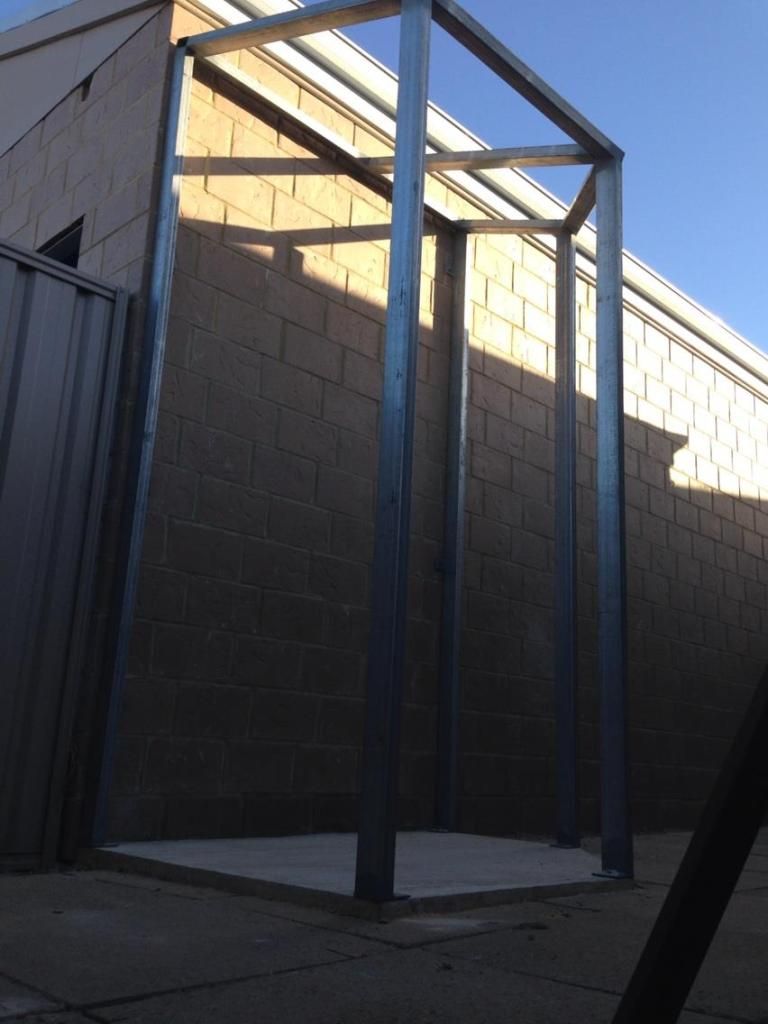
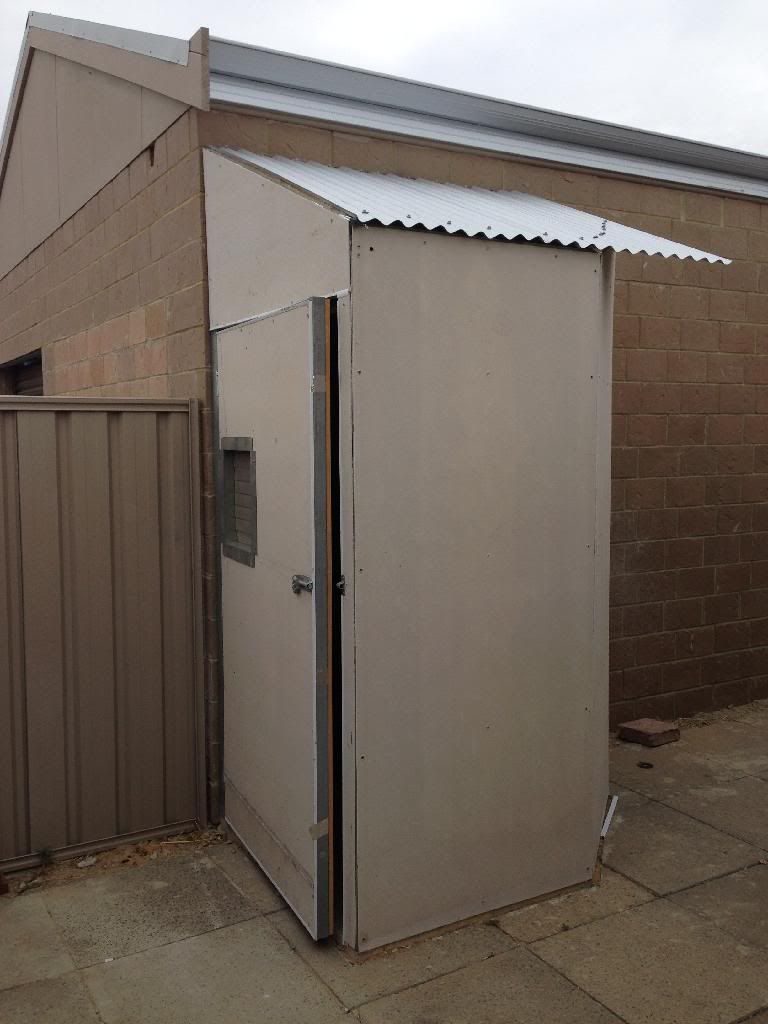

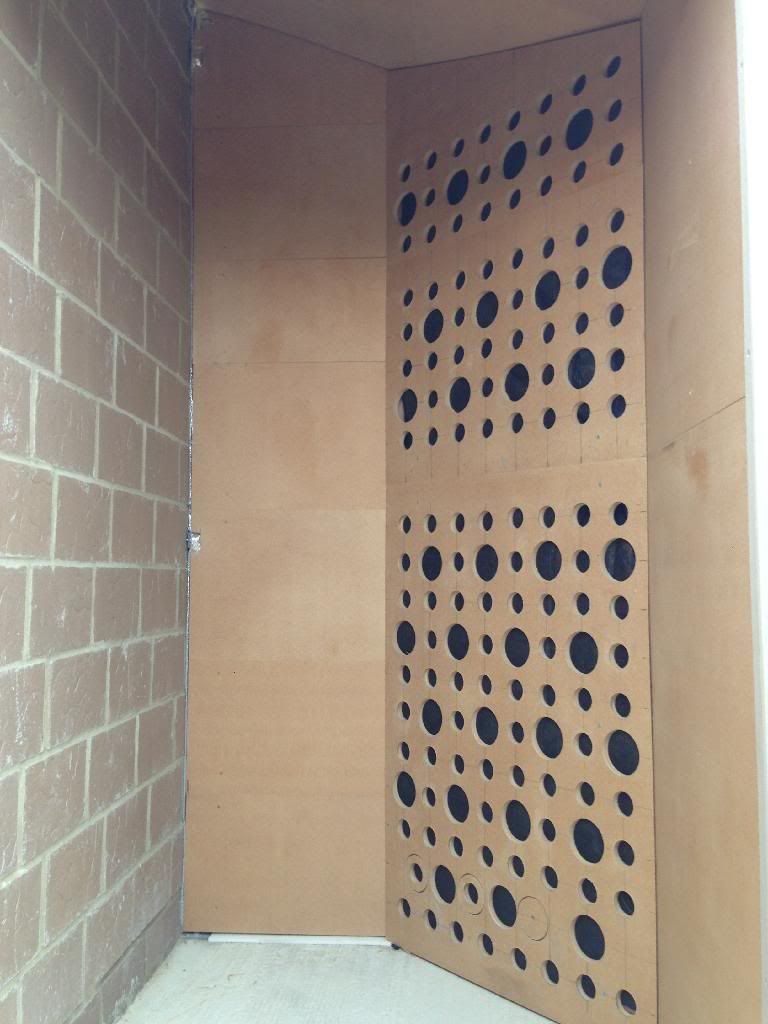
Still yet to test as I've got a few things to do to before I organise ducting into the shed. I don't have any spl test measurement gear but I may pick up a cheap SPL meter from Jaycar. The bass trap should be able to be tuned by tightening the screws holding the baffle in place so the SPL meter may help with that.
Any comment's or ideas welcome. I'm not precious about my design in any way, please feel free to poke holes in my logic
-
18th December 2013 11:25 AM # ADSGoogle Adsense Advertisement
- Join Date
- Always
- Location
- Advertising world
- Posts
- Many
-
18th December 2013, 01:14 PM #2
 .
.











- Join Date
- Feb 2006
- Location
- Perth
- Posts
- 27,794

I doubt there will be much air resonance involved in a DC enclosure that is about the same size as the DC as the DC takes up a substantial amount of the internal volume which will prevent standing waves from being established.
It would be would be better if the air was let out on the other side of the bass trap rather than around the door..
Also how will you stop the MDF down near the ground from getting wet?
No need to buy a SPL meter if you have newish mobile phone as there are plenty of free apps around that are reasonably accurate.
-
18th December 2013, 01:59 PM #3
 Senior Member
Senior Member











- Join Date
- Dec 2004
- Location
- Perth
- Posts
- 324

Probably wasn't obvious from the other pics but there is a 350*350 balanced louvre vent in the door facing out to the road.
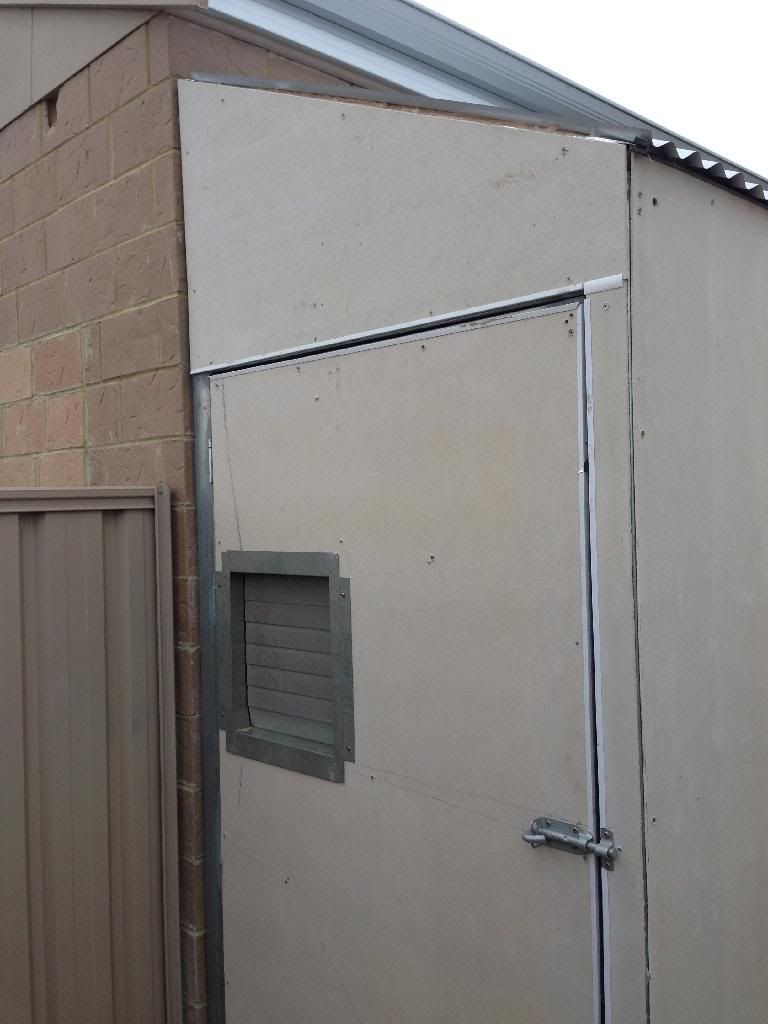
The bass trap is on that wall as it faces directly into the neighbors back yard so I didn't really want any vents facing that way but I agree, that would have been the place to vent it.
The mdf doesn't touch the ground (it's about 10mm above it.
Any tips on an iPhone db meter? Seems some attenuate the mic input.
-
18th December 2013, 02:43 PM #4
 Retired
Retired











- Join Date
- Jul 2007
- Location
- Kiewa
- Age
- 64
- Posts
- 1,636

I was wondering where all the air dragged into the room would go? The vents seem small and if you open the door while in use, the noise will still be present?
-
18th December 2013, 03:11 PM #5
 .
.











- Join Date
- Feb 2006
- Location
- Perth
- Posts
- 27,794

OK.
If it's on the non-weather side and is kept clear of dust/leaf debris etc that might be enough.The mdf doesn't touch the ground (it's about 10mm above it.
It only needs a a little wet debris up against the edge and water will wick into MDF very quickly and if it rains hard and pools from run off it can be a real problem
On my first enclosure I used 50 mm treated pine as a stand off for the DC enclosure to stand on, and on my latest enclosure I have used 75 mm high galv SHS section, then I have 75 x 35 mm treated pine frame above that.
Yep the internal microphone on most mobile phones struggles below 100 Hz and really struggles at less than 50 Hz where it jumps all over the place.Any tips on an iPhone db meter? Seems some attenuate the mic input.
The Apple engineers have allowed for this as much as they can but it means that iPhone SPL apps will unreliable for low frequencies
In terms of comparative general SPL sensitivity I found the iPhone3 struggles below ~50 dB and I would be wary about any reading below that level. There are some people reporting ~20dB SPLs with mobile phones that I take with a grain of salt. I did not do any upper SPL testing
I used several meters to check my DC enclosure, a cheap Chinese SPL, an iPhone, and a decent Radioshack SPL that I borrowed from work (that had been checked against a pro level Bruel and Kjaer meter)
The 3 meters produced the same results (+/- 2 dB) from 100 dB down to ~ 50 dB. Below that the iPhone tended to produce results that were consistently on the low side but not by that much maybe 2-3 dB down to about 40 dB.
This could be just my phone - I should test out SWMBO's iPhone5.
I did not do any frequency comparisons but I was surprised that the iPhone gave the same SPL as the Radioshack meter when I was diagnosing my low frequency rumble problem that I had with around my DC enclosure.
After doing my testing I read up a bunch of stuff online and my experience is pretty similar to what others report.
My take is the basic mobile phone apps are fine for direct comparison of DC SPLs at those intermediate SPLs - comparison of results between different phones are less reliable
-
18th December 2013, 03:30 PM #6
 Senior Member
Senior Member











- Join Date
- Dec 2004
- Location
- Perth
- Posts
- 324

It was a worry of mine as well. I originally had 2 * 350mm louvre vents in the original design but when I worked out the csa of 1 vent and the door gap it was 3 times the inlet csa so decided it would be ok with just one. Less openings, less noise.
The slab sits 80mm higher than the surrounding paving and the cement sheet runs down 30mm past the top of the slab so not too worried about the mdf. It's a very sealed little box.
Initial tests (performed by locking a very angry 2 year old inside) have proved positive. Hopefully this weekend's trial go well.
Thanks for the info Bob. I also found this on my travels through the internet.
A Review Of 30 Sound (Noise) Measurement Apps « Popular « Safety Awakenings
-
18th December 2013, 04:29 PM #7
 .
.











- Join Date
- Feb 2006
- Location
- Perth
- Posts
- 27,794

Thanks for the lead - interesting reading there.
I worry about these "Choice Magazine type test" where they test only one device/phone and then all sorts of claims are made on that single device.
Perhaps more critically "None of the apps had a proper built-in calibrator so we used the factory default calibration settings in all cases."
I guess they are just doing what an average Joe would do so that is I suppose fair enough, but it is possible that using another phone the results could be quite different.
And none of these Apps overcome the low frequency limitations of the internal microphones on these devices.
If I were going to invest $ in an SPL App I'd be looking at one that could at least be calibrated, and would maybe take a calibrated external microphone.
Meanwhile even the free Apps should serve as basic comparative indicators.
-
18th December 2013, 05:27 PM #8

Hi dalejw, I've also gone down a path similar to you. I made a DC cabinet with treated pine frame and cement sheeting but with a (now) large exhaust port down low on one side.
I was going to line it with insulation and framing ply, but the reduction in noise is so great that I may not bother. From 87dB (door open) to around 62dB @ 1m from the door, 58dB @ 3m (Sound level meter).
My wife is now able to run it at night as it's virtually inaudible, something we initially thought would be impossible to do.
Looking forward to your results with the extra insulation you are using.
-
18th December 2013, 05:29 PM #9
 .
.











- Join Date
- Feb 2006
- Location
- Perth
- Posts
- 27,794
-
18th December 2013, 07:29 PM #10

Sound level meter from Jaycar, had it a few years. I have non portable calibrated Mic's and real time DSP MLS software from my Motional feedback design years.
The unit is within a few dB but more importantly tracks well between upper and lower limits. Most importantly as the difference between cabinet open and closed readings are correct. In the end it came down to complete isolation from the Shed, solid dense cabinet base, only one controlled exit point for any sound to travel through and enough bracing to stop MF/LF panel resonance.
-
18th December 2013, 07:45 PM #11
 Senior Member
Senior Member











- Join Date
- Dec 2004
- Location
- Perth
- Posts
- 324

Saw your setup and drew a lot of comfort from the sound reduction you were getting. I decided to throw everything I had at this one given the proximity to the neighbors and the fact I'm going to be running this a lot at night initially. The table saw and thicknesser (spiral head) are almost inaudiable outside the shed and I'd hate to wind up with grumpy neighbors this early into the project.
-
28th January 2014, 03:54 PM #12
 Senior Member
Senior Member











- Join Date
- Dec 2004
- Location
- Perth
- Posts
- 324

So finally moved the DC into its own enclosure and have some data.
92db in the large shed (very resonant).
87 db in front of the enclosure with the door open.
82db in front of the enclosure with the door closed.
75db @ 1m behind the enclosure (door closed).
70db at the neighbors fence (3 meters)
Baseline reading is about 68db at the fence. There's a major intersection nearby.
I can't help feeling that these numbers are ######## though. What is apparent though from the spectral plot is the reduction around the 60hz area. This is the area the iphone mic is least sensitive around and the area that I was targeting with the bass trap. There's a big reduction at the fence in this area which I was pleased about.
It sounds about the same as using a vacuum cleaner in the house. It's not very intrusive for such a large piece of gear.
-
28th January 2014, 04:18 PM #13
 .
.











- Join Date
- Feb 2006
- Location
- Perth
- Posts
- 27,794

Good work Dale - the improvements sound like they are well worth it.
So others can compare the following info would be helpful
Where in the shed is the DC located and how far from the DC and above floor level is the SPL level taken.
Also what are the internal walls made of.
How far from the DC and above ground level?87 db in front of the enclosure with the door open.
How far from the DC and above ground level?82db in front of the enclosure with the door closed.
How far above ground level is the SPL level taken?75db @ 1m behind the enclosure (door closed).
How far above ground level is SPL level taken?70db at the neighbors fence (3 meters)
What's the SPL inside the shed with all the ports open?
-
28th January 2014, 04:37 PM #14
 Senior Member
Senior Member











- Join Date
- Dec 2004
- Location
- Perth
- Posts
- 324

Correct BobL, should have given some more data.
All measurements at @1800mm above floor level and @ 1m horizontal unless otherwise stated.
All ports open inside the shed is about 85db (fairly consistent noise in all areas of the shed @ 1800mm high) but this is all wind noise from the ports. Drops to about 75db with everything closed.
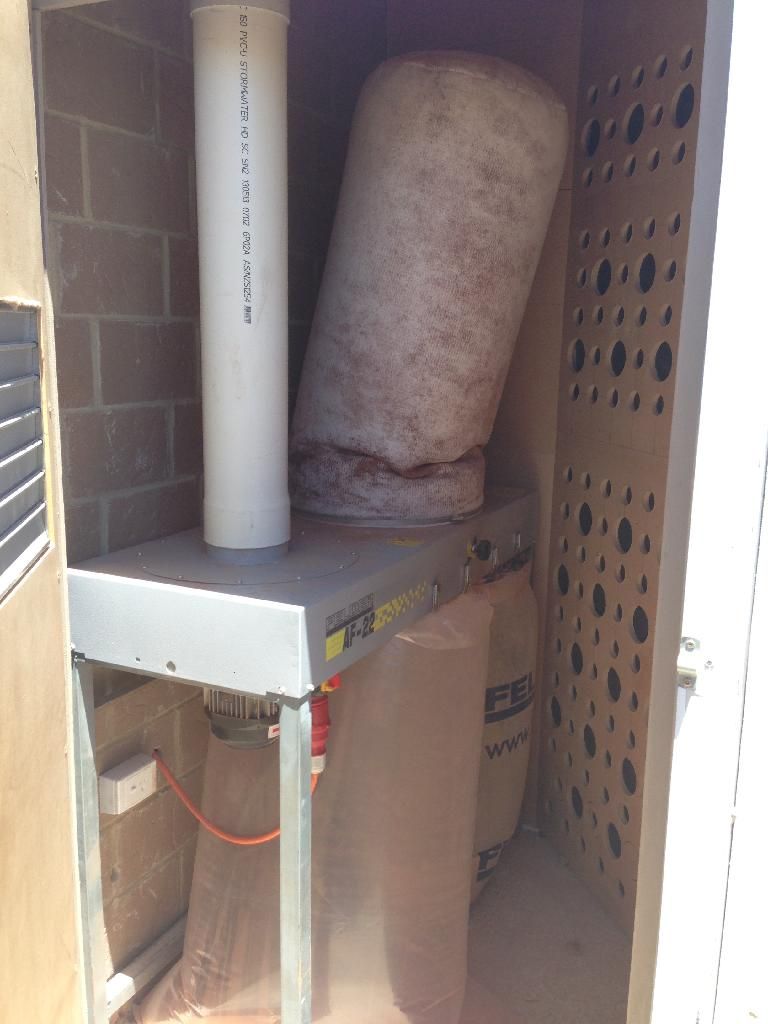
The one thing I am going to try is a short piece of flexi 6" duct high up before the elbow running into the shed to try and isolate the vibration in the dust extractor from all the ducting.
The PVC is very resonant and I'm sure the vibrations from the DC are resonating through the pipework giving that low frequency rumble. It's isolated using rubber mounts from the slab and the initial readings from the DC running in the main shed (with just a piece of 5" flexi connected to the inlet) didn't have that same 40-60hz lump.
-
28th January 2014, 07:57 PM #15
 .
.











- Join Date
- Feb 2006
- Location
- Perth
- Posts
- 27,794

Thanks - that is useful.
This sounds a little bit high (all my measurements are at 1.8m high and are dbA measurements done using the Faber Acoustical Soundmeter 4, iphone App)All ports open inside the shed is about 85db (fairly consistent noise in all areas of the shed @ 1800mm high) but this is all wind noise from the ports. Drops to about 75db with everything closed.
In the middle of my shed I have 75 dB with all ports (2 TS, 3 BS, 1 Lathe and 1 thickener) open and 62 db with all ports closed.
At the moment there is not much wind and my shed Baseline is 50 db, outside the baseline is 51 db.
Outside at neighbours fence which is only about 500 mm from the enclosure I have 64 db, 3 m from the enclosure its 60 db
My enclosure outlet is larger than yours and is down low at ground level which will make a difference.
My naked DC (taken outside with no walls to reflect sound) is fairly quiet anyway, being 80 db at 1m and at 1m height above the ground.
How long is your longest run of unsupported PVC ducting - the longest for my system is about 1.8 m and all my corners have at least 2 metal clamp supports.The PVC is very resonant and I'm sure the vibrations from the DC are resonating through the pipework giving that low frequency rumble. It's isolated using rubber mounts from the slab and the initial readings from the DC running in the main shed (with just a piece of 5" flexi connected to the inlet) didn't have that same 40-60hz lump.
Similar Threads
-
Best way to approach this join?
By moofactory in forum WOODWORK - GENERALReplies: 9Last Post: 7th October 2012, 07:41 PM -
Model Sculpture,An Artistic Approach.Model Sculpture,An Artistic Approach. I am plann
By JohnReid in forum WOODCARVING AND SCULPTUREReplies: 37Last Post: 7th July 2011, 12:56 PM -
..uhh Durwood what's the best approach here?
By fanlee in forum FINISHINGReplies: 3Last Post: 12th October 2006, 12:49 PM -
the tradesman's approach
By la Huerta in forum WOODWORK - GENERALReplies: 20Last Post: 10th March 2006, 07:18 AM -
How do you approach your work
By Craig Gordon in forum WOODWORK - GENERALReplies: 9Last Post: 25th August 2004, 01:34 AM



 Likes:
Likes: 
 Reply With Quote
Reply With Quote

